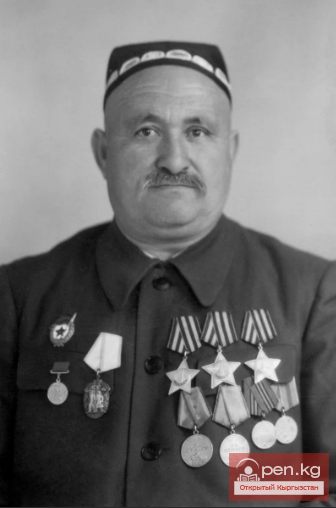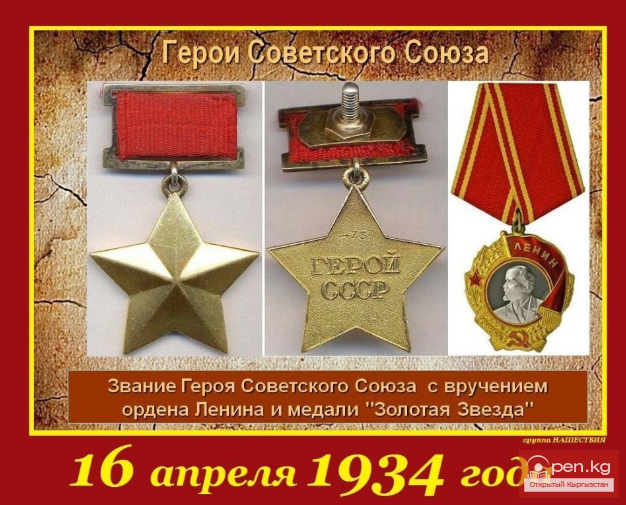
How Glory Got Its Order
In November 1943, when it became clear that the war would end in victory over Germany, a new award was introduced — the Order of Glory. The initiative for its creation came from Stalin himself. Discussions about the regalia first took place in June 1943 at a meeting of the People's Commissariat of Defense, where the project for the Order of Victory was being discussed.
The Order of Glory was intended to be awarded to privates and junior command staff for heroic feats accomplished on the battlefield. It was expected to have a very high status, virtually equal to that of military regalia.
The task of developing the new order was assigned to the technical committee of the Main Supply Directorate. Work on its creation began here in August 1943, with a team of nine artists working on the sketch. After three months, they prepared 26 designs for the order, of which four were presented to Stalin. Ultimately, the Supreme Commander approved the work of artist Moskalev, who was the author of the designs for all the medals for the defense of Soviet cities.
Initially, the order was to have four degrees and replicate the famous Order of St. George, one of the most respected royal awards among the people. The regalia was even planned to be named the Order of Bagration.
However, Stalin thought differently and named it as we know it today, explaining: "There is no victory without glory." He reduced the number of degrees to three, analogous to "military orders." The first degree was considered the highest. Awards were given sequentially: first, a serviceman received the Order of the III degree, then the II degree, and finally the I degree.
An interesting detail: full knights of the Order of Glory could receive an extraordinary military rank. Thus, privates and sergeants automatically became sergeants major, sergeants became junior lieutenants, and junior lieutenants became lieutenants. By the way, until 1974, the Order of Glory was the only Soviet regalia awarded exclusively for personal merits. Military units, organizations, and enterprises were never nominated for it.
The Order of Glory is a five-pointed star. In its central part is an image of the Kremlin's Spasskaya Tower. A laurel wreath runs around the circumference of the medallion. At the bottom of the circle is the inscription "Glory." On the reverse side of the award is a circle with the inscription USSR. The differences between the orders of the first, second, and third degrees lie in the material of manufacture. The regalia of the first degree is gold, the second is silver with gilding of the central medallion, and the third is completely silver. The Order of Glory is worn on the left side of the chest and, when there are other Soviet orders, is placed after the Order of the Badge of Honor in order of seniority of degrees.
The right to award the Order of Glory III degree was granted to commanders of units in the active army from the rank of brigade commander and above. Soldiers could be nominated for the Order of Glory II degree by army or flotilla commanders. The first degree could only be awarded upon the recommendation of the Presidium of the Supreme Soviet of the USSR.
The Order of Glory is awarded to those who:
Were the first to break into the enemy's position and, through personal bravery, contributed to the success of the overall effort;
While in a burning tank, continued to carry out a combat mission;
In a moment of danger, saved the banner of their unit from capture by the enemy;
With personal weapons, accurately shot and destroyed from 10 to 50 enemy soldiers and officers;
In battle, with the fire of an anti-tank rifle, incapacitated at least two enemy tanks;
Destroyed from one to three tanks with hand grenades on the battlefield or in the enemy's rear;
With artillery or machine-gun fire, destroyed at least three enemy aircraft;
Disregarding danger, was the first to burst into the enemy's pillbox (dugout or shelter) and decisively destroyed its garrison;
As a result of personal reconnaissance, identified weak points in the enemy's defense and led our troops into the enemy's rear;
Personally captured an enemy officer;
At night, removed or captured an enemy guard post (outpost, sentry);
Personally, with ingenuity and courage, sneaked up to the enemy's position and destroyed their machine gun or mortar;
During a night raid, destroyed an enemy supply depot with military equipment;
Risking their life, saved a commander in battle from immediate danger;
Disregarding personal danger, captured an enemy flag in battle;
While wounded, returned to the ranks after bandaging;
With personal weapons, shot down an enemy aircraft;
By destroying enemy artillery or mortar positions with fire, ensured the successful actions of their unit;
Under enemy fire, created a passage for the advancing unit through the enemy's barbed wire obstacles;
Risking their life, under enemy fire, assisted the wounded during several battles;
While in a damaged tank, continued to carry out a combat mission with the tank's weapons;
Rushed into an enemy column with their tank, crushed it, and continued to carry out a combat mission;
With their tank, crushed one or several enemy guns or destroyed at least two machine-gun nests;
While on reconnaissance, obtained valuable information about the enemy;
A fighter pilot shot down from two to four enemy fighter aircraft in aerial combat or from three to six bombers;
An attack pilot, as a result of an assault raid, destroyed from two to five enemy tanks or from three to six locomotives, or blew up a train at a railway station or on a stretch of track, or destroyed at least two aircraft at the enemy airfield;
An attack pilot, as a result of bold initiative in aerial combat, destroyed one or two enemy aircraft;
The crew of a daytime bomber destroyed a railway train, blew up a bridge, a munitions depot, fuel depot, destroyed the headquarters of an enemy unit, demolished a railway station or stretch of track, blew up a power station, blew up a dam, destroyed a military vessel, transport, boat, and destroyed at least two enemy aircraft at their airfield;
The crew of a light night bomber blew up a munitions depot, fuel depot, destroyed enemy headquarters, blew up a railway train, blew up a bridge;
The crew of a long-range night bomber destroyed a railway station, blew up a munitions depot, fuel depot, destroyed a port facility, destroyed naval transport or a railway train, demolished or burned an important factory or plant;
The crew of a daytime bomber for a bold action in aerial combat, resulting in the downing of from one to two aircraft;
The crew of a reconnaissance aircraft for successfully completed reconnaissance, resulting in valuable data about the enemy.
The first award occurred on November 13, 1943, just five days after the establishment of the new award. The Order of Glory III degree was awarded to sapper Senior Sergeant Malyshev. During a battle, the soldier approached an enemy machine gun that was hindering the advance of Soviet troops and destroyed it. Later, Malyshev would also receive the Order of Glory II degree. According to other sources, the first award was given to Sergeant Israelyan, also a sapper. Apparently, Malyshev was nominated for the order first, but he actually received it later than Israelyan.
The first recipients of the Order of Glory II degree in history were the sappers of the 10th Army from the 1st Belorussian Front — Privates Vlasov and Baranov. By the end of the Great Patriotic War, both of these fighters also received the Order of Glory I degree.
The first to be awarded the Order of Glory I degree in July 1944 was Senior Sergeant Shevchenko. He was the assistant commander of a reconnaissance platoon in an independent ski battalion. At the same time, the full knight was sapper Private Pitenin. However, the soldier did not live to receive the award. Shevchenko was much luckier in this regard; he successfully survived the war. During the fighting, he was awarded three Orders of Glory and three other Soviet military orders. This circumstance made him a true phenomenon. In those years, not every colonel and even general had six such awards.
During the war, there was quite an interesting case when an entire unit — all its soldiers, except for the officer corps — were awarded the Order of Glory. This refers to the 1st Battalion of the 215th Rifle Regiment of the 77th Guards Division. In the battles for the liberation of Poland during the breakthrough of the German defense line on the Vistula on January 14, 1945, the soldiers managed to capture three rows of enemy trenches and held their positions until the main assault forces arrived. During this battle, Guards Sergeant Petrov repeated the feat of Matrosov, closing the embrasure of a German pillbox with his chest. The officers were also not left without awards; platoon commanders were nominated for the Order of Alexander Nevsky, company commanders for the Order of the Red Banner, and the battalion commander, Guards Major Emelyanov, became a Hero of the Soviet Union. Posthumously.
In total, about one million Orders of Glory III degree were awarded for distinctions during the Great Patriotic War, more than 46 thousand of the second degree, and 2672 of the first. It was established after the war that among the 2672 full knights of the Order of Glory, there were 80 individuals who mistakenly had four Orders of Glory instead of three, as one of the lower degrees was duplicated. Among the full knights of the Order of Glory was also a person awarded five orders at once. He was nominated three times for the Order of Glory II degree, but due to a criminal record, he was stripped of titles and regalia.
The youngest full knight of the Order of Glory was Junior Sergeant Ivan Kuznetsov. At the age of 16, he was nominated for the Order of I degree. There are only 47 such young heroes.
Among more than two and a half thousand full knights of the Order of Glory, four were awarded the title of Hero of the Soviet Union:
Artilleryman Guards Senior Sergeant Aleshin A.V.;
Attack pilot Junior Lieutenant Aviation Drachenko I.G.;
Marine Guards Senior Sergeant Dubinda P.H.;
Artilleryman Senior Sergeant Kuznetsov N.I. (received the Order I degree only in 1980).

Among the full knights of the Order of Glory, there were four women:
Sniper Senior Sergeant Petrova N.P. (killed in battle on May 1, 1945, born in 1893!);
Machine gunner of the 16th Lithuanian Division Sergeant Staniliene D.Y.;
Nurse Senior Sergeant Nozdračeva M.S.;
Air gunner-radio operator of the 99th Separate Guards Reconnaissance Aviation Regiment Guards Senior Sergeant Zhurkina N.A.
Kyrgyzstanis – Full Knights of the Order of Glory











































